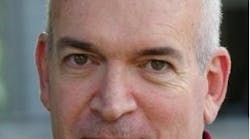“Big companies are off the sidelines at this point,” he said. Indeed, in an audience replete with large company CIOs, a show of hands indicated that about half of those in attendance were in the process of deploying IoT initiatives. He pointed out that Ford made an early commitment to IoT and now has 120 people focused on the technology at a Silicon Valley facility.
Nor is it just big business. Richard Soley, Executive Director of the Industrial Internet Consortium (IIC), cited an agribusiness success where one farmer used sensors and other technology to boost milk production by 40 percent!
“We are still very early in adoption; I compare it to the situation for home computing in the early 1980s where nobody knew what to do except play games; with IoT we are now starting to flesh out the use cases,” says Markus Weinberger, director of the Bosch IoT Lab at the Univeristy of St. Galllen in Switzerland.
Putting his finger on what he sees as the challenges to adopting IIoT, Michael Chui, a partner at McKinsey Globe Institute, noted that there is already too much data; only about one percent of the data collected in some applications is ever used, he reckons. So, the challenge will be crunching the numbers and finding ways to act on them. In parallel with that problem, Chui says technology sales people have gotten ahead of the business. In other words, management may be willing to invest in new technology such as IIoT but the management practices needed to make the most of the new tech often lags far behind.
Strategically, though, Soley says the real IIoT “story” is the way it will shift more spending from capex to opex. “IoT provides more information about the equipment you use, information the manufacturer didn’t have previously,” he says. And that may radically change business practices. For instance, according to Soley, when GE sells a locomotive to a railroad company, they may earn several times the original purchase price over the 30 year lifespan of the machine in repair parts. Instrumenting every step of the way can improve that process. Likewise, turbines in aircraft (or in other applications) are now capable of generating vast amounts of operational data, which should lead to improved operational efficiency. The door may then be opening for customers paying for a certain number of pounds of thrust for a given time period – a service in essence – rather than for an outright purchase of hardware.
Turning all the blue sky, future-oriented IIoT talk into real investments and action will depend on articulating and sharing more use cases, according to Soley. “The use cases we are developing at IIC include manufacturing improvements and more efficient, safer, and better integration of wind and solar into the grid.” Finally, he added, the IIoT industry should start looking now to address systemic issues like interoperability and security that are inhibiting adoption.
Alan R. Earls is a Boston-based writer focused on technology, business, and manufacturing — a field where he spent the earliest part of his career. He has written for publications and websites as diverse as The Boston Globe, Computerworld and Modern Infrastructure as well as Industry, The Manufacturer, and Today's Machining World.




